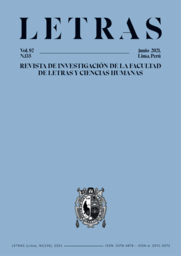Violencia femicida en 2666 de Roberto Bolaño
Resumen
“La parte de los crímenes”, uno de los segmentos de la novela 2666 (2004) de Roberto Bolaño, versiona en clave ficcional, sobre la base de investigaciones periodísticas, registros oficiales y de organizaciones sociales, la serie de múltiples asesinatos de mujeres perpetrados en Ciudad Juárez, México, a fines del siglo pasado ycomienzos del presente. El propósito de este artículo es indagar la representación artística de la extrema violencia que se ensaña en los cuerpos femeninos de modo desbordado e irracional, hasta configurar una visión apocalíptica de la ciudad latinoamericana. La escritura contamina el registro testimonial con la ficción para plasmar la violencia feminicida, un procedimiento que elude el carácter controversial del testimonio y, en cambio, concentra toda la potencia del relato en la exploración del mal en sus múltiples encarnaciones. El texto combina la parodia del estilo burocrático-administrativo con fragmentos narrativos que otorgan voz a los muchos personajes involucrados en los sucesos. Tal entramado discursivo auspicia no solo la denuncia de estos crímenes silenciados por las autoridades sino también la indagación de las determinaciones políticas, culturales, económicas que convergen en las atrocidades cometidas contra las mujeres. Documentos y testimonios son procesados en la máquina ficcional, fusionando la literatura con otras narrativas que resisten la amenaza de deshumanización.Descargas
Métricas alternativas
Referencias bibliográficas
Agamben, G. (2004). Estado de excepción. Buenos Aires: Adriana Hidalgo editora.
Aguilar, P. (2015). Violencia y literatura en América Latina a partir de 2666 de Roberto Bolaño. En T. Basile (Coord.), Literatura y violencia en la narrativa latinoamericana reciente (pp. 172-194). Buenos Aires: Universidad Nacional de La Plata.
Arendt, H. (2015 [1969]). Sobre la violencia. Buenos Aires: Alianza Editorial.
Bajtín, M. (2012). Problemas de la poética de Dostoievski. Ciudad de México: Fondo de Cultura Económica.
Bolaño, R. (1996). Estrella distante. Barcelona: Anagrama.
Bolaño, R. (2010 [2004]). 2666. Barcelona: Anagrama.
Bolaño, R. (2011). Entre paréntesis. Barcelona: Anagrama.
Candia, A. (2006). 2666: la magia y el mal. Revista digital Taller de Letras, 38, 121-139.
Franco, J. (2016). Una modernidad cruel. Ciudad de México: Fondo de Cultura Económica.
González Rodríguez, S. (2002). Huesos en el desierto. Barcelona: Anagrama (Edición en formato digital, junio 2010).
Hutcheon, L. (1993). La política de la parodia posmoderna. Criterios, La Habana (Edición especial de homenaje a Bajtín). Traducción del inglés: Desiderio Navarro. https://www.mnba.gob.cl/617/articles-8672_archivo_04.pdf
Jelin, E. (2002). Los trabajos de la memoria. Madrid: Siglo Veintiuno Editores.
Levi, P. (2005). Los hundidos y los salvados. En Trilogía de Auschwitz. Barcelona: El Aleph.
Logie, I. (2014). 2666 o la legitimidad de la literatura en tiempos “post”. Revista Iberoamericana, 80 (247), 611-630. https://doi.org/10.5195/REVIBEROAMER.2014.7169
Ludmer, J. (2010). Aquí, América Latina. Una especulación. Buenos Aires: Eterna Cadencia Editora.
Segato, R. L. (2003). Las estructuras elementales de la violencia: ensayos sobre género entre la antropología, el psicoanálisis y los derechos humanos. Bernal: Universidad Nacional de Quilmes.
Segato, R. L. (2017 [2016]). La guerra contra las mujeres (Edición argentina). Buenos Aires: Tinta Limón.
Valencia, S. (2010). Capitalismo gore. Madrid: Melusina.
Žižek, S. (2017 [2009]). Sobre la violencia. Barcelona: Paidós.
Derechos de autor 2021 Letras (Lima)

Esta obra está bajo licencia internacional Creative Commons Reconocimiento 4.0.
Este obra está bajo una licencia de Creative Commons Reconocimiento 4.0 Internacional



















